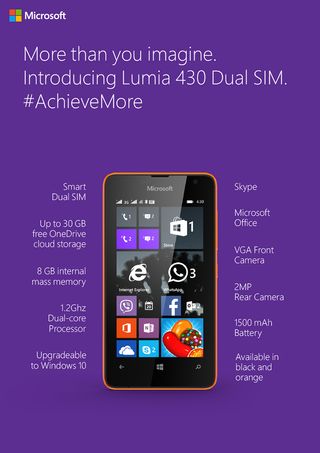New Lumia 430 Costs $70, Microsoft Continues Low-End Smartphone Strategy

Earlier this month, we discussed Microsoft's global low-end smartphone strategy, and today Microsoft is continuing on that path with the release of the Lumia 430.
The Lumia 430, as the name suggests, is the smallest and least powerful of Microsoft's new smartphones. It's also the least expensive at a mere $70.
It features a 4-inch display with a resolution of 800 x 480, dropping PPI down to 235. Naturally, with the smaller size and being designed as a low-end phone, the battery capacity also drops down to 1500 mAh, which is half that of the upcoming Lumia 640 XL.
Maximum talk time has dropped by over half compared to the Lumia 640 smartphones, but battery life when using compute intensive applications like games should not decrease too much, as the hardware inside is also less powerful and should consume less power.
The Lumia 430's storage and memory are the same as the upcoming Lumia 640 and 640 XL, featuring 8 GB of internal storage (expandable with up to 128 GB via microSD card) and 1 GB RAM.
To save costs, Microsoft opted for a dual-core Qualcomm Snapdragon 200 SoC running at 1.2 GHz, instead of the Snapdragon 400 SoC inside of the Lumia 640 and 640XL. Looking at the list of Qualcomm Snapdragon 200 processors, we find that only two are dual-core units rated at 1.2 GHz -- Snapdragon 200 8210 and Snapdragon 200 8610.
From this information, we are able to ascertain that the CPUs inside are ARM Cortex-A7. The GPU is either an Adreno 302 or Adreno 305, but the spec is very similar for both, so the GPU difference shouldn't vary greatly either way.
Stay on the Cutting Edge
Join the experts who read Tom's Hardware for the inside track on enthusiast PC tech news — and have for over 25 years. We'll send breaking news and in-depth reviews of CPUs, GPUs, AI, maker hardware and more straight to your inbox.
Of all the tradeoffs Microsoft employed in the Lumia 430 to keep the price low, the one that users will feel most is the camera. Although the front camera is rated the same as many budget smartphones at 0.3 MP, the back camera is only 2.0 MP and isn't capable of taking 1080p video, with a max still photo resolution of 1600 x 1200.
Fortunately, the dual-SIM capabilities are a prominent feature. Dual-SIM support has become very popular in recent years, especially for people who need separate phone numbers for work and their personal lives and don't want the hassle of carrying two devices.
The smartphone is estimated to cost $70, which should make it quite competitive in the budget phone market. It is expected to enter the market sometime in April, around the time the Lumia 640 and Lumia 640 XL will launch.
Follow us @tomshardware, on Facebook and on Google+.
-
ohim When will MS learn that most of the people don`t like their ugly tile screen. They will never gain market share from the android power users with their OS until they will let the user customize the damn phone. They have a great OS but the visual design is terrible and some lonatic in MS tries to impose it to the world.Reply -
Oblyviousg You my friend are an idiot. WP is not designed for power users. Its a simple phone OS designed to work. No one ois forcing you to use WP or any other OS.Reply
I have been using Android and WP since both came out. WP IMO is more stable and more intuitive than its Android counterpart.
I would really like to know what Android can do that WP cannot in retrospect to what the average user needs and wants a mobile device to achieve. -
falchard I think he likes his uniformist blocks that inefficiently use up his screen real-estate. The only difference from a usability standpoint is the different screens for selecting applications to run.Reply
From that screen, you can see the guy has 2 phone numbers with missed calls on each, a couple text messages to each, 1 application update, 2 Skype messages, 2 emails, no facebook notification, and... 3 updates to comments he has made in the store. -
SamQ LOL At that thickness (nearly 1/2 inch) they could have easily left in a 3,000 battery and used an HD screen (for another $20 I know). The dimensions are ideal IMHO otherwise. Just what we've been looking for in fact. Did I mention we're not big fans of the new phones that require a purse or a man-servant to carry around? The new Sony Xperia Z3 Compact is nearly perfect ... except it isn't on Verizon (the local gorilla). Cannot catch a break.Reply
Most Popular

